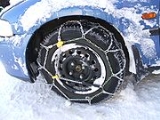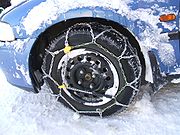
Snow chains
Encyclopedia

Tire
A tire or tyre is a ring-shaped covering that fits around a wheel rim to protect it and enable better vehicle performance by providing a flexible cushion that absorbs shock while keeping the wheel in close contact with the ground...
s of vehicles to provide maximum traction when driving through snow
Snow
Snow is a form of precipitation within the Earth's atmosphere in the form of crystalline water ice, consisting of a multitude of snowflakes that fall from clouds. Since snow is composed of small ice particles, it is a granular material. It has an open and therefore soft structure, unless packed by...
and ice
Ice
Ice is water frozen into the solid state. Usually ice is the phase known as ice Ih, which is the most abundant of the varying solid phases on the Earth's surface. It can appear transparent or opaque bluish-white color, depending on the presence of impurities or air inclusions...
.
Snow chains are attached to the drive wheel
Drive wheel
A drive wheel is a roadwheel in an automotive vehicle that receives torque from the powertrain, and provides the final driving force for a vehicle. A two-wheel drive vehicle has two driven wheels, and a four-wheel drive has four, and so-on....
s of a vehicle. Chains are usually sold in pairs and must be purchased to match a particular tire size (tire diameter and tread width). Driving with chains will reduce fuel efficiency and can reduce the speed of the automobile to approximately 30 mph (50 km/h).
Deployment
In snowy conditions, transportation authorities may require snow chains or other traction aids on vehicles. The requirement could apply to all vehicles, or only those that lack special motive features, such as four-wheel driveFour-wheel drive
Four-wheel drive, 4WD, or 4×4 is a four-wheeled vehicle with a drivetrain that allows all four wheels to receive torque from the engine simultaneously...
and/or a certain type of tires. Local requirements may be enforced at checkpoints or by other type of inspection. Snow chains should be installed on one or more drive axles of the vehicle, with requirements varying for dual-tire or multi-driven-axle vehicles that range from 'one pair of tires on a driven axle' to 'all tires on all driven axles' requiring snow chains whenever required by sign-age or conditions.
Snow chains were invented in 1904 by Harry D. Weed in Canastota, New York. Weed received U.S. Patent Number 768495 for his "Grip-Tread for Pneumatic Tires" on August 23, 1904. Weed's great-grandson, James Weed, said Harry got the idea of creating chains for tires when he saw drivers who would wrap rope, or even vines, around their tires to increase traction on muddy or snowy roads, which were the norm at the turn of the 20th century. He sought to make a traction device that was more durable and would work with snow as well as mud.
United States
Tires come with standardized tire codeTire code
Automobile tires are described by an alphanumeric tire code or tyre code , which is generally molded into the sidewall of the tire. This code specifies the dimensions of the tire, and some of its key limitations, such as load-bearing ability, and maximum speed...
sizing information, found on the sidewalls of the tires. The first letter(s), indicate the vehicle type (P for passenger, LT for light truck). The next three digits indicates the tire's width in millimeters. The middle two digit number indicates the tire's height-to-width ratio. The next character is a letter 'R,' which indicates radial ply tires (rather than radius). followed by a final two digit number indicating the rim size for the vehicle's wheels.
Additionally, the correct Society of Automotive Engineers (SAE) class of snow chains must be installed, based on the wheel clearance of the vehicle.
| SAE traction device class | Minimum tread-face clearance (A) | Minimum side-wall clearance (B) |
|---|---|---|
| Class S | 1.46 in | .59 in |
| Class U | 1.97 in | .91 in |
| Class W | 2.50 in | 1.50 in |
The SAE Class "S" well clearance is a common requirement on newer cars, especially if after-market wider, low-profile, or larger tires and/or wheels are fitted.
The classes are defined as follows:
- SAE Class S - Regular (non-reinforced) passenger tire traction devices for vehicles with restricted wheel well clearance.
- SAE Class U - Regular (non-reinforced) and lug-reinforced passenger tire traction devices for vehicles with regular (non-restricted) wheel well clearances.
- SAE Class W - Passenger tire traction devices that use light truck components, as well as some light truck traction devices.
Common chain failures
- Driving too fast with chains. Maximum speed recommended in the chain's owner's manual - generally 30 to 50 km/h (20-30 mph) - maximum.
- Driving on dry roads with chains for extended periods of time.
- Not securing the chains tightly enough. Manuals recommend to tighten a second time after driving a short distance, and check for tightness from time to time. If a chain comes loose, it should be refastened or removed before it wraps around the vehicle's drive axle.
- Tensioners or adjusters may be required. (Some chains do not require tensioners and may be damaged if tensioners are used.)
- Installing chains on non driven wheels.
Alternatives
- Diamond chains - diamond pattern car or truck chains
- Link chains - same as tire chains or snow chains
- Traction cables - formed from cable wire instead of chain links
- Cable chains - Same as traction cables
- Snow cables - Same as traction cables
- Snow tiresSnow tiresSnow tires are tires designed for use in winter conditions, such as snow and ice. They are an alternative to the use of snow chains.Snow tires are usually tires with a different rubber composition from all-weather tires...
, tires with deep and wide slots and knobby treads to grab snow to aid traction - Studded tires - snow tires with metal studs used in icy conditions - legal in certain conditions only
- Spider shaped chain mounted onto the tires from the side
- Sock - fabric rather than chain or cable
- Polyurethane or rubber instead of chain
Legality of use
Laws vary considerably regarding the legality of the use of snow chains. Some jurisdictions may require them to be used in certain snowy conditions or during certain months of the year, while other states or jurisdictions may prohibit their use altogether to preserve the surface of the roads.External links
- Comparison of United States' snow chain legal status per state, published by the Wisconsin Motor Carriers Association
- Yosemite National Park Tire Chains Page
- Snow chain regulations in Europe
- Regulations for every US State

